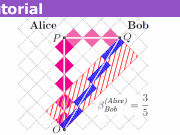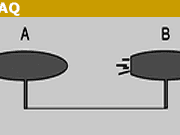Learn the Relativistic Work-Kinetic Energy Theorem
I was bothered for a long time by the reasons for the relativistic validity of the work-kinetic energy relation ##\Delta E=Fd##, which holds without any need for corrections. We’ve discussed this before here on PF, but I think at this point I understand it better, so I thought I’d post a summary of my present understanding.
Table of Contents
Einstein’s treatment
At one time I somehow got the idea that Einstein had never given any logical justification for the fact that ##\Delta E=Fd## was valid and exact relativistically. I think this was because I hadn’t carefully thought through section 10 of “On the electrodynamics…,” where he actually gives a rigorous treatment. He starts with two assumptions:
(1) We have ##ma=eE## for the motion of an electron in any instantaneously comoving frame, in an electric field E. (He explicitly uses two such frames.). There’s no way this can be subject to a correction factor such as ##\gamma##, since the electron is at rest.
(2) The electrical potential energy of an electron is given by ##eV##. This is firmly established by experiment, and it doesn’t involve motion, so there is no reasonable way that we could imagine that it would need a correction factor like ##\gamma##. In the example of a small spherical shell of charge between two capacitor plates, it’s derivable from the equation for the energy density of the field
He’s also worked out the transformations of the fields (E,B) and the coordinates, so starting from assumption 1 he’s able to find the dynamical laws in a frame where the electron is moving. He uses these dynamical laws, along with assumption 2, to find the kinetic energy of the electron at relativistic speeds.
Along the way, he also does the following. His dynamical laws give, in the parallel direction, ##eE=m\gamma^3a##, and he calls this the force (in the parallel direction), which is equivalent to the common modern definition of the three-force as ##dp/dt##. Because of assumption 2, it follows that ##\Delta E=Fd## holds exactly; he is *not* assuming ##\Delta E=Fd##, he’s proving it (for this definition of force).
Using the relativistic energy-momentum four-vector
A more modern approach is as follows. Suppose that we’ve already determined the properties of the energy-momentum four-vector. This includes the relativistic definition of mass, ##m^2=E^2-p^2##, and also the identity ##p/E=v##. Then is becomes pretty straightforward to show that ##W=Fd## is relativistically exact. Consider one-dimensional motion, and let ##p## be the momentum component along our one spatial dimension. Define ##F=dp/dt##. Then
## \frac{d E}{d x} = \frac{d E}{dp}\frac{d p}{d t} \frac{d t}{d x} = \frac{d E}{d p} \frac{F}{v} ##
By implicit differentiation of the definition of mass, we find that ##dE/dp=p/E##, and this in turn equals ##v## by the identity above. This leads to the claimed result, which is valid for both massless and material particles.
Using simple machines
I always felt that there should be some way of getting at the problem this way, but I don’t think it ends up working. Suppose we have a simple machine with mechanical advantage ##A##. At least some simple machines (such as a lever) are capable of operating rigidly (based on the definition of Born-rigidity) for arbitrary relativistic motion. (Many others are not, because rigid motion would violate the Herglotz-Noether theorem. For example, a screw undergoing accelerated motion through a set of threads at relativistic speeds would bind.) For a machine that does work relativistically, the ratio of the input and output displacements is fixed to the exact value ##1/A##, without relativistic correction.
The proportionality of work to ##F## and to ##d## follows from elementary considerations, independent of relativity. See the Feynman lectures, section I-4-2.
What seems more problematic in these arguments is the following. Suppose we have two things that could be called “force,” ##F## and ##G##, and let them differ by ##G=F h(v)##, where ##h## is some function and ##v## is the velocity of an object being acted upon. These could be, e.g., ##F=dp/dt## and ##G=dp/d\tau## (the spacelike component of the force four-vector). In this example, it turns out that the forces at the input and output of the machine are related by ##F_1/F_2=A##, while ##G_1/G_2\ne A##, but how do you show this? I don’t think you can show it without some other argument, as in the two sections above.
PhD in physics. I teach physics at Fullerton College, a community college in Southern California. I enjoy writing, playing viola, brewing beer, climbing and mountaineering.








[USER=260864]@vanhees71[/USER]: Again, this is not at all on topic for this thread.
Sure, ray optics is all you need for this purpose. For things like the redshift-distance relation in cosmology you need its proper definition via the eikonal approximation of the Maxwell equations in a given background spacetime (here the FLRW pseudometric), usually for spherical waves.
It’s also historically interesting that in the 1930ies there was a debate about the correct interpretation of the Hubble redshift, where distinguished physicists like von Laue were involved. There they also had the debate, whether the already then favored derivation in the naive photon picture is correct. Finally Robertson showed, how to derive the relation within classical electromagnetics. It’s downloadable from NASA (I think not behind a paywall):
Robertson, H. The apparent luminosity of a receding nebula Zeitschrift für Astrophysik 15, 1938, 69
[URL]http://adsabs.harvard.edu/abs/1938ZA…..15…69R[/URL]
Concerning massless particles I’ll think about simple examples for motion of massless particles in a static electric or magnetic field. If trouble occurs, which I don’t expect, I’ll open a posting. Otherwise it will immediately go in my SRT writeup :-).
[QUOTE=”vanhees71, post: 5211935, member: 260864″]Ok, so that’s well understood by classical electromagnetism. No naive-photon picture is needed.[/QUOTE]
I would put it the other way around. Ray optics is all you need for the application I mentioned, so there is no need for classical electromagnetism or quantum mechanics. Ray optics is not a “naive-photon picture.” In any case, I think this is of little or no relevance to the topic of this thread. If you want to start a separate thread on the status of massless particles in classical relativity, that might be more appropriate IMO.
Ok, so that’s well understood by classical electromagnetism. No naive-photon picture is needed. What’s usually done is just the eikonal approximation to classical electromagnetism (i.e., ray optics derived from wave optics). Photons in a curved background spacetime are a quite tricky business!
[QUOTE=”vanhees71, post: 5211167, member: 260864″]In which sense has gravitational lensing to do with the motion of massless particles? Well, you might interpret ray optics (i.e., the eikonal approximation for classical electromagnetic waves) as massless-particle motion.[/QUOTE]
Yes.
In which sense has gravitational lensing to do with the motion of massless particles? Well, you might interpret ray optics (i.e., the eikonal approximation for classical electromagnetic waves) as massless-particle motion. In this sense the naive photon picture is not completely wrong…
[QUOTE=”vanhees71, post: 5211097, member: 260864″]Can you give an example where one does this? Anyway, there’s of course nothing wrong with it from a theoretical point of view. You can have perfectly valid equations of motion for massless particles.[/QUOTE]
Gravitational lensing would be a good example.
Can you give an example where one does this? Anyway, there’s of course nothing wrong with it from a theoretical point of view. You can have perfectly valid equations of motion for massless particles.
I don’t think #12 is the same as saying that massless particles don’t “make sense” classically. In any case, we deal with massless particles constantly in classical relativity, and we do it in practical contexts that relate directly to observation.
Very simple: There are no classical massless particles, at least I’ve never heard that one has observed them yet. This makes much sense from the point of view of quantum field theory. The only candidate that comes to mind within the standard model would be a photon, but this is the quantum (one-particle Fock state) of the electromagnetic field, which is a massless spin-1 field and thus necessarily a gauge field, and you cannot define a position observable in the strict sense. So it is hard to imagine, how to get a classical particle limit. The classical limit is that of classical electromagnetic fields, i.e., coherent states with a large average photon number rather than classical point particles.
The other massless fields in the Standard Model are the gluon fields, but the corresponding quanta, the gluons, are confined, so one cannot expect to find them as particles in the sense of a classical limit.
The very last possibility would be that one of the neutrinos is in fact massless. It’s hard to say at the present empirical status. If it would exist, it may be a candidate for something that could make sense as a classical approximation in the sense of a massless particle.
[QUOTE=”vanhees71, post: 5210133, member: 260864″]”massless particles” (which don’t make too much sense in classical (i.e., non-quantum) relativistic physics anyway)[/QUOTE]
Why?
Inspired by this thread and bcrowells remark in #8 on “massless particles” (which don’t make too much sense in classical (i.e., non-quantum) relativistic physics anyway), I’ve extended the section on “naive dynamics” (i.e., dynamics not employing Hamilton’s principle of least action) in my SRT writeup by giving a derivation of the work-energy theorem and also a formulation of the dynamics of massless particles:
[URL]http://fias.uni-frankfurt.de/~hees/pf-faq/srt.pdf[/URL]
[QUOTE=”Jano L., post: 5207538, member: 193673″]I do not know what Einstein was getting at there. I am not sure proving the relation ##E=gamma mc^2## makes sense. I think this is just a definition of energy, same as ##frac{1}{2}mv^2## is definition of kinetic energy in classical mechanics.[/QUOTE]
Definitions are like babies. They have to come from somewhere. Einstein is proving that this equation is the only one for a massive particle that is consistent with Maxwell’s equations. In any case, this is not a definition of energy, since it doesn’t apply to massless particles.
[QUOTE=”pervect, post: 5207389, member: 14402″]I’m not too sure my thoughts will be helpful for the intended purpose (which I assume ultimately involves a simple presentation of special relativity), but perhaps they’ll provide some insight. And they can be expressed pretty briefly. As long as special relativity has a non-trivial Hamiltonian, we can write Hamilton’s equations:
[tex]frac{partial H}{partial q} = dot {p}[/tex]
Now, if we can also identify H with energy, q with position, and ##dot{p}## with force, then we have the work-energy theorem, the rate of change of the energy with position must be equal to the force.[/QUOTE]
This is an interesting approach, but if we examine it carefully I think it’s not quite as much of a slam-dunk as it might seem. And it does have the disadvantage that it won’t work as a presentation at the undergraduate level, since a physics major might not be exposed to Hamiltonian mechanics until after taking their upper-division SR course.
Spelling out the steps in more detail, I think we would have the following:
(1) The action has to be Lorentz-invariant and additive, and the only possibility that seems to present itself is ##S=(ldots)mint_{t_1}^{t_2} dtau##, where … represents a constant.
(2) Working backward from this, infer that the Lagrangian for a free relativistic particle in one dimension is ##L=(ldots)m/gamma##.
(3) Find the conjugate momentum, which is ##p=(ldots)mgamma v##.
(4) Interpret ##dp/dt## as a force.
(5) Calculate the Hamiltonian.
(6) Identify the Hamiltonian with the energy.
(7) Use Hamilton’s equations to associate ##partial H/partial x## with minus the force.
The first thing to note is that this is much, much longer than the simple derivation I gave (the second of the three sections in my original post).
The next problem is that we have foundational issues in steps 1 and 4. Maybe there’s an explicit uniqueness theorem one could give at step 1? Otherwise it’s just a plausibility argument, with no a priori guarantee, for example, that the final result will come out consistent with Maxwell’s equations in the case of a charge moving in a field. In step 4, we have to decide what is the best definition of force. One could argue that this definition is good, because by the time we get to step 7 we will have shown that it preserves the form of the work-energy theorem without correction. But this is a weak justification if we aren’t at step 7 yet, and in fact we have a different definition of force, the four-force, which a priori would be preferable because it’s tensorial.
At step 6, we have to check some technical criteria.
A general philosophical objection to the whole thing is that Hamiltonian mechanics lacks manifest Lorentz invariance at every step of the way. In particular, time is treated as a parameter rather than a coordinate.
[QUOTE=”bcrowell, post: 5207518, member: 211768″]
There are two disadvantages to your method. (1) In the 1905 paper, Einstein uses ##Delta E=Fd## to prove ##E=mgamma c^2##, so he can’t use the latter to prove the former. (2) Your method doesn’t work for massless particles.[/QUOTE]
I do not know what Einstein was getting at there. I am not sure proving the relation ##E=gamma mc^2## makes sense. I think this is just a definition of energy, same as ##frac{1}{2}mv^2## is definition of kinetic energy in classical mechanics.
[QUOTE=”Jano L., post: 5207326, member: 193673″]I see the ## way of writing formulae does not work well, so here’s my comment in plaintext:
I have trouble seeing what is the problem you’re trying to solve. The relation W=Fd is definition of work, not the work-energy theorem.[/QUOTE]
Right, I should have notated this as ##Delta E=Fd##.
[QUOTE=”Jano L., post: 5207326, member: 193673″] The work-energy theorem says work equals change in kinetic energy of the particle. This follows mathematically from the equation of motion md(γv)/dt=F and Einstein’s definition of energy E=γmc^2.[/QUOTE]
There are two disadvantages to your method. (1) In the 1905 paper, Einstein uses ##Delta E=Fd## to prove ##E=mgamma c^2##, so he can’t use the latter to prove the former. (2) Your method doesn’t work for massless particles.
I’m not too sure my thoughts will be helpful for the intended purpose (which I assume ultimately involves a simple presentation of special relativity), but perhaps they’ll provide some insight. And they can be expressed pretty briefly. As long as special relativity has a non-trivial Hamiltonian, we can write Hamilton’s equations:
[tex]frac{partial H}{partial q} = dot {p}[/tex]
Now, if we can also identify H with energy, q with position, and ##dot{p}## with force, then we have the work-energy theorem, the rate of change of the energy with position must be equal to the force.
In Classical mechanics we do not need ##E=Fd##, that we can calculate ##E\propto v^2##. The same is valid in SR. Thus I agree with BCrowell and disagree with Jano L. ##E\propto v^2## can be obtained with help of quadratic forms. I showed how to calculate this https://www.physicsforums.com/threads/quadratic-forms-and-kinetic-energy.826884/But my question was about references about quadratic forms? Can you help me. Best regards
I see the ## way of writing formulae does not work well, so here's my comment in plaintext:I have trouble seeing what is the problem you're trying to solve. The relation W=Fd is definition of work, not the work-energy theorem. The work-energy theorem says work equals change in kinetic energy of the particle. This follows mathematically from the equation of motion md(γv)/dt=F and Einstein's definition of energy E=γmc^2.
I have trouble seeing what is the problem you're trying to solve. The relation ##W=Fd## is definition of work, not the work-energy theorem. The work-energy theorem says work equals change in kinetic energy of the particle. This follows mathematically from the equation of motion ##md(\gamma v)/dt = F## and Einstein's definition of energy ##E=\gamma mc^2##.